Addressing IHRM Challenges in Multinational Firms - BUS851
VerifiedAdded on 2023/01/13
|12
|2993
|38
Report
AI Summary
This report critically analyzes the challenges faced by multinational organizations in the realm of International Human Resource Management (IHRM). It identifies key issues such as talent shortages, employee compensation and benefits, and expatriate failure, particularly within the Australian market. The report discusses the impact of globalization on HRM practices and the complexities arising from diverse cultural patterns. It further examines specific challenges like attracting and retaining skilled managerial personnel, the shortage of talent in specific fields, and the impact of compensation structures on employee satisfaction. The high failure rate of expatriates due to culture shock and its subsequent effects on productivity and engagement are also explored. Finally, the report provides recommendations including robust support systems for expatriates, enhanced employee compensation strategies, and analytical techniques to cultivate talent, aiming to mitigate these challenges and improve IHRM practices in multinational companies.
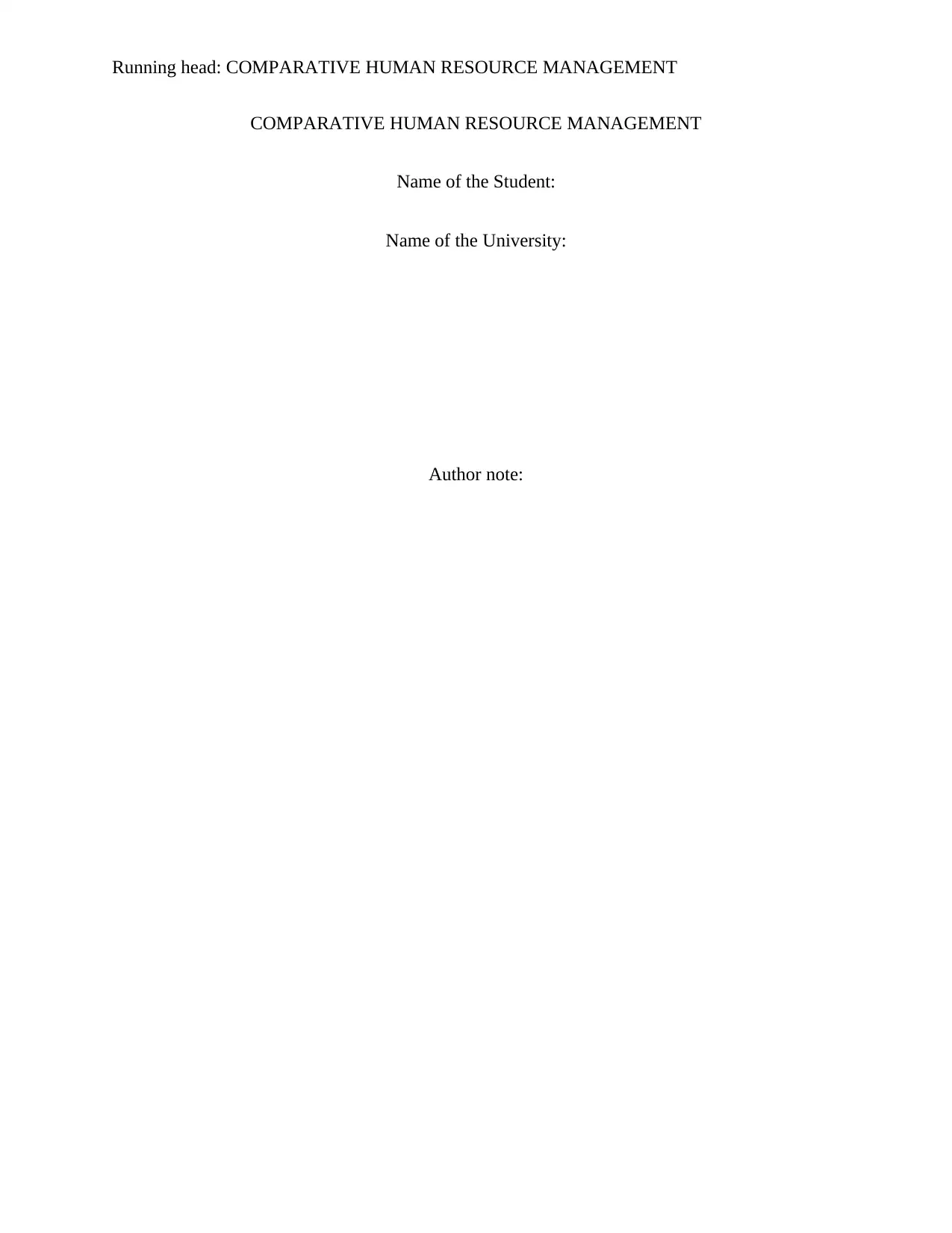
Running head: COMPARATIVE HUMAN RESOURCE MANAGEMENT
COMPARATIVE HUMAN RESOURCE MANAGEMENT
Name of the Student:
Name of the University:
Author note:
COMPARATIVE HUMAN RESOURCE MANAGEMENT
Name of the Student:
Name of the University:
Author note:
Paraphrase This Document
Need a fresh take? Get an instant paraphrase of this document with our AI Paraphraser
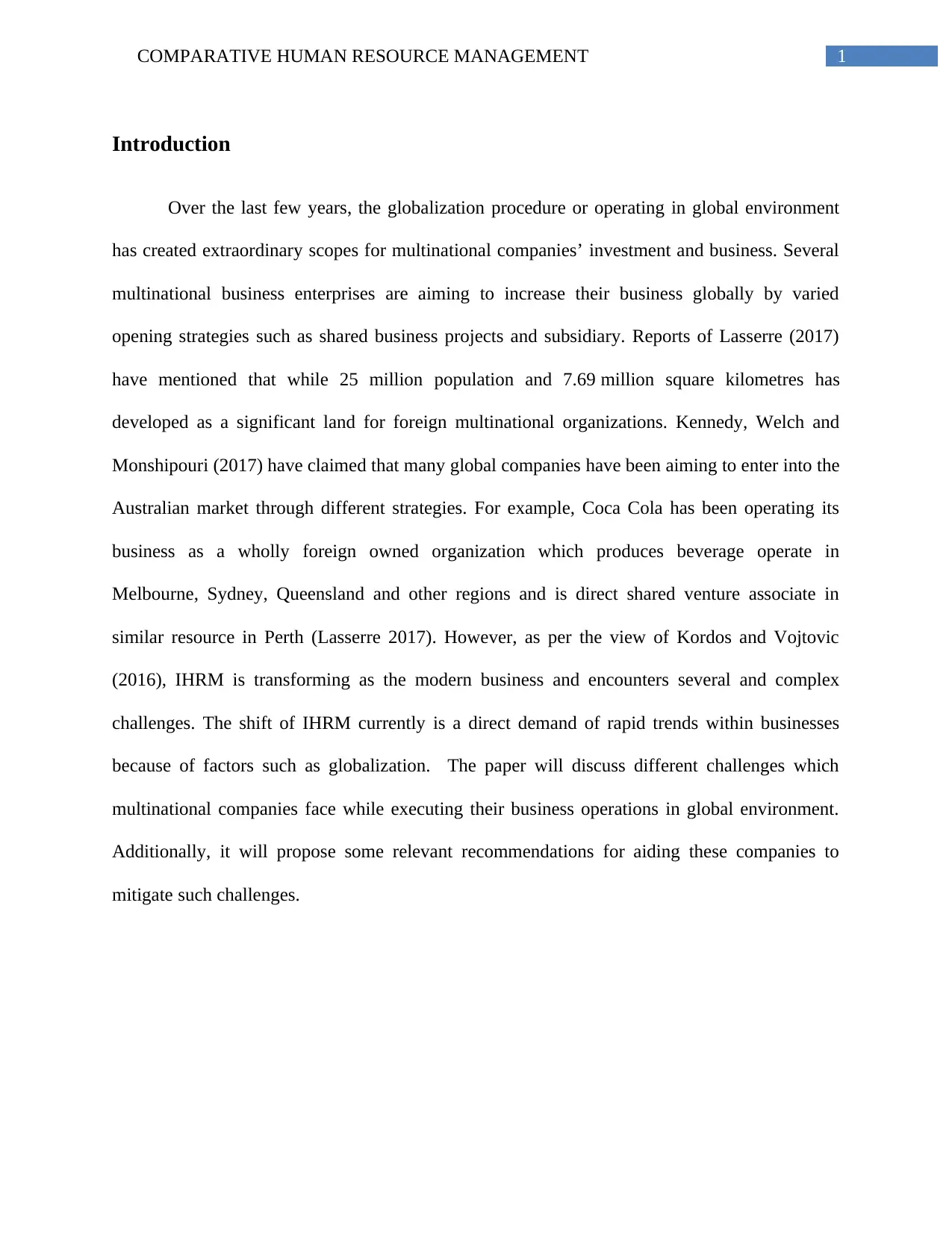
1COMPARATIVE HUMAN RESOURCE MANAGEMENT
Introduction
Over the last few years, the globalization procedure or operating in global environment
has created extraordinary scopes for multinational companies’ investment and business. Several
multinational business enterprises are aiming to increase their business globally by varied
opening strategies such as shared business projects and subsidiary. Reports of Lasserre (2017)
have mentioned that while 25 million population and 7.69 million square kilometres has
developed as a significant land for foreign multinational organizations. Kennedy, Welch and
Monshipouri (2017) have claimed that many global companies have been aiming to enter into the
Australian market through different strategies. For example, Coca Cola has been operating its
business as a wholly foreign owned organization which produces beverage operate in
Melbourne, Sydney, Queensland and other regions and is direct shared venture associate in
similar resource in Perth (Lasserre 2017). However, as per the view of Kordos and Vojtovic
(2016), IHRM is transforming as the modern business and encounters several and complex
challenges. The shift of IHRM currently is a direct demand of rapid trends within businesses
because of factors such as globalization. The paper will discuss different challenges which
multinational companies face while executing their business operations in global environment.
Additionally, it will propose some relevant recommendations for aiding these companies to
mitigate such challenges.
Introduction
Over the last few years, the globalization procedure or operating in global environment
has created extraordinary scopes for multinational companies’ investment and business. Several
multinational business enterprises are aiming to increase their business globally by varied
opening strategies such as shared business projects and subsidiary. Reports of Lasserre (2017)
have mentioned that while 25 million population and 7.69 million square kilometres has
developed as a significant land for foreign multinational organizations. Kennedy, Welch and
Monshipouri (2017) have claimed that many global companies have been aiming to enter into the
Australian market through different strategies. For example, Coca Cola has been operating its
business as a wholly foreign owned organization which produces beverage operate in
Melbourne, Sydney, Queensland and other regions and is direct shared venture associate in
similar resource in Perth (Lasserre 2017). However, as per the view of Kordos and Vojtovic
(2016), IHRM is transforming as the modern business and encounters several and complex
challenges. The shift of IHRM currently is a direct demand of rapid trends within businesses
because of factors such as globalization. The paper will discuss different challenges which
multinational companies face while executing their business operations in global environment.
Additionally, it will propose some relevant recommendations for aiding these companies to
mitigate such challenges.
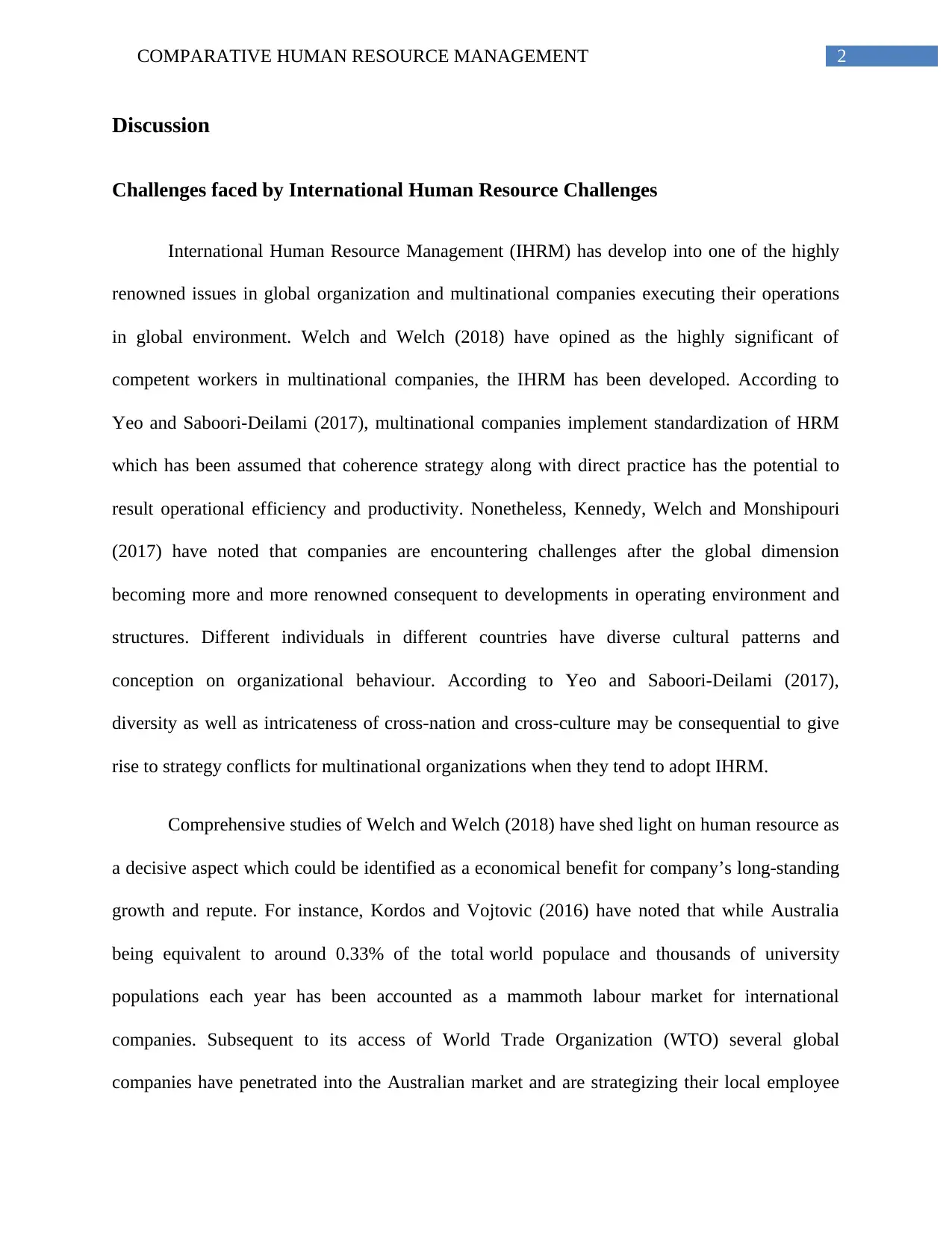
2COMPARATIVE HUMAN RESOURCE MANAGEMENT
Discussion
Challenges faced by International Human Resource Challenges
International Human Resource Management (IHRM) has develop into one of the highly
renowned issues in global organization and multinational companies executing their operations
in global environment. Welch and Welch (2018) have opined as the highly significant of
competent workers in multinational companies, the IHRM has been developed. According to
Yeo and Saboori-Deilami (2017), multinational companies implement standardization of HRM
which has been assumed that coherence strategy along with direct practice has the potential to
result operational efficiency and productivity. Nonetheless, Kennedy, Welch and Monshipouri
(2017) have noted that companies are encountering challenges after the global dimension
becoming more and more renowned consequent to developments in operating environment and
structures. Different individuals in different countries have diverse cultural patterns and
conception on organizational behaviour. According to Yeo and Saboori-Deilami (2017),
diversity as well as intricateness of cross-nation and cross-culture may be consequential to give
rise to strategy conflicts for multinational organizations when they tend to adopt IHRM.
Comprehensive studies of Welch and Welch (2018) have shed light on human resource as
a decisive aspect which could be identified as a economical benefit for company’s long-standing
growth and repute. For instance, Kordos and Vojtovic (2016) have noted that while Australia
being equivalent to around 0.33% of the total world populace and thousands of university
populations each year has been accounted as a mammoth labour market for international
companies. Subsequent to its access of World Trade Organization (WTO) several global
companies have penetrated into the Australian market and are strategizing their local employee
Discussion
Challenges faced by International Human Resource Challenges
International Human Resource Management (IHRM) has develop into one of the highly
renowned issues in global organization and multinational companies executing their operations
in global environment. Welch and Welch (2018) have opined as the highly significant of
competent workers in multinational companies, the IHRM has been developed. According to
Yeo and Saboori-Deilami (2017), multinational companies implement standardization of HRM
which has been assumed that coherence strategy along with direct practice has the potential to
result operational efficiency and productivity. Nonetheless, Kennedy, Welch and Monshipouri
(2017) have noted that companies are encountering challenges after the global dimension
becoming more and more renowned consequent to developments in operating environment and
structures. Different individuals in different countries have diverse cultural patterns and
conception on organizational behaviour. According to Yeo and Saboori-Deilami (2017),
diversity as well as intricateness of cross-nation and cross-culture may be consequential to give
rise to strategy conflicts for multinational organizations when they tend to adopt IHRM.
Comprehensive studies of Welch and Welch (2018) have shed light on human resource as
a decisive aspect which could be identified as a economical benefit for company’s long-standing
growth and repute. For instance, Kordos and Vojtovic (2016) have noted that while Australia
being equivalent to around 0.33% of the total world populace and thousands of university
populations each year has been accounted as a mammoth labour market for international
companies. Subsequent to its access of World Trade Organization (WTO) several global
companies have penetrated into the Australian market and are strategizing their local employee
⊘ This is a preview!⊘
Do you want full access?
Subscribe today to unlock all pages.

Trusted by 1+ million students worldwide
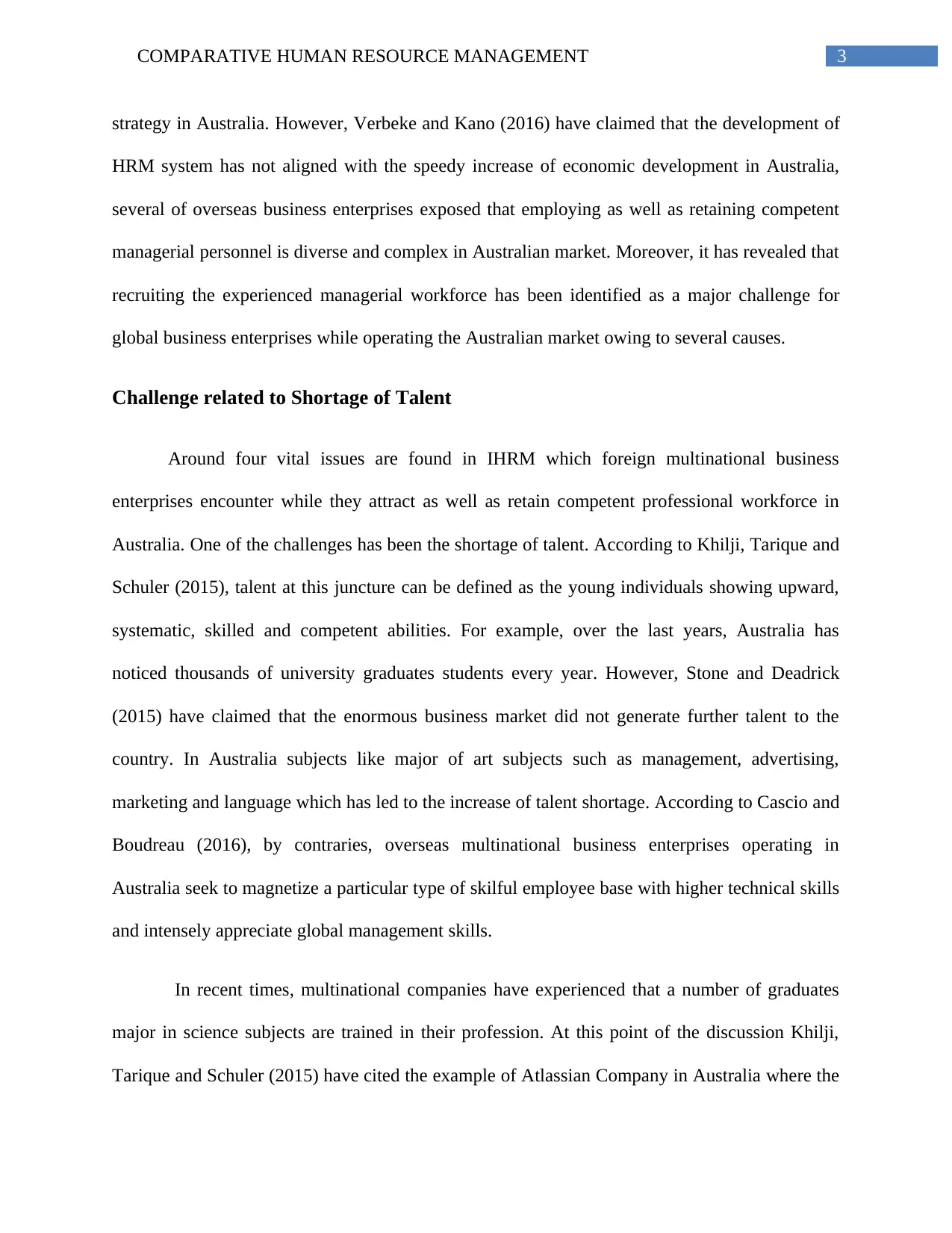
3COMPARATIVE HUMAN RESOURCE MANAGEMENT
strategy in Australia. However, Verbeke and Kano (2016) have claimed that the development of
HRM system has not aligned with the speedy increase of economic development in Australia,
several of overseas business enterprises exposed that employing as well as retaining competent
managerial personnel is diverse and complex in Australian market. Moreover, it has revealed that
recruiting the experienced managerial workforce has been identified as a major challenge for
global business enterprises while operating the Australian market owing to several causes.
Challenge related to Shortage of Talent
Around four vital issues are found in IHRM which foreign multinational business
enterprises encounter while they attract as well as retain competent professional workforce in
Australia. One of the challenges has been the shortage of talent. According to Khilji, Tarique and
Schuler (2015), talent at this juncture can be defined as the young individuals showing upward,
systematic, skilled and competent abilities. For example, over the last years, Australia has
noticed thousands of university graduates students every year. However, Stone and Deadrick
(2015) have claimed that the enormous business market did not generate further talent to the
country. In Australia subjects like major of art subjects such as management, advertising,
marketing and language which has led to the increase of talent shortage. According to Cascio and
Boudreau (2016), by contraries, overseas multinational business enterprises operating in
Australia seek to magnetize a particular type of skilful employee base with higher technical skills
and intensely appreciate global management skills.
In recent times, multinational companies have experienced that a number of graduates
major in science subjects are trained in their profession. At this point of the discussion Khilji,
Tarique and Schuler (2015) have cited the example of Atlassian Company in Australia where the
strategy in Australia. However, Verbeke and Kano (2016) have claimed that the development of
HRM system has not aligned with the speedy increase of economic development in Australia,
several of overseas business enterprises exposed that employing as well as retaining competent
managerial personnel is diverse and complex in Australian market. Moreover, it has revealed that
recruiting the experienced managerial workforce has been identified as a major challenge for
global business enterprises while operating the Australian market owing to several causes.
Challenge related to Shortage of Talent
Around four vital issues are found in IHRM which foreign multinational business
enterprises encounter while they attract as well as retain competent professional workforce in
Australia. One of the challenges has been the shortage of talent. According to Khilji, Tarique and
Schuler (2015), talent at this juncture can be defined as the young individuals showing upward,
systematic, skilled and competent abilities. For example, over the last years, Australia has
noticed thousands of university graduates students every year. However, Stone and Deadrick
(2015) have claimed that the enormous business market did not generate further talent to the
country. In Australia subjects like major of art subjects such as management, advertising,
marketing and language which has led to the increase of talent shortage. According to Cascio and
Boudreau (2016), by contraries, overseas multinational business enterprises operating in
Australia seek to magnetize a particular type of skilful employee base with higher technical skills
and intensely appreciate global management skills.
In recent times, multinational companies have experienced that a number of graduates
major in science subjects are trained in their profession. At this point of the discussion Khilji,
Tarique and Schuler (2015) have cited the example of Atlassian Company in Australia where the
Paraphrase This Document
Need a fresh take? Get an instant paraphrase of this document with our AI Paraphraser
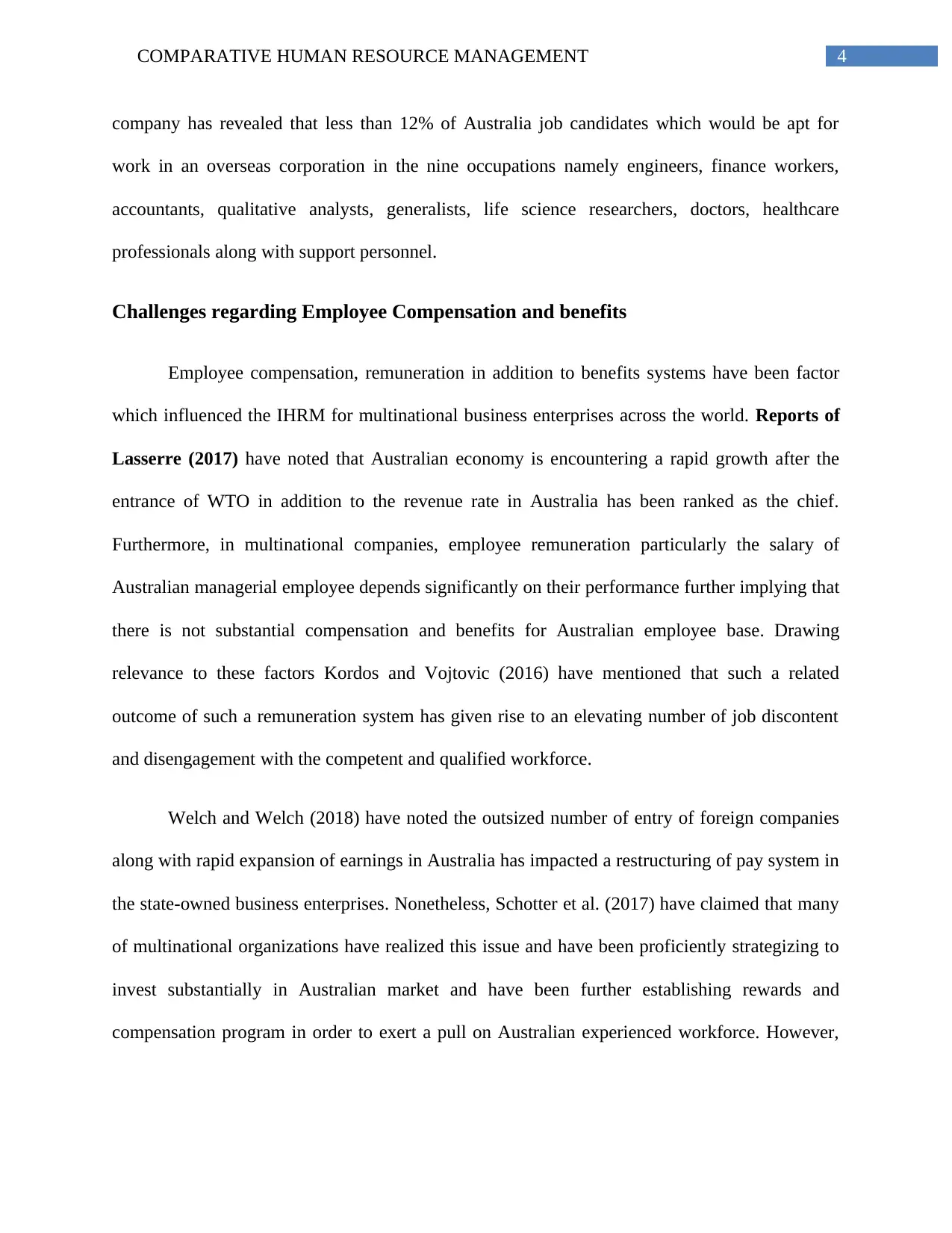
4COMPARATIVE HUMAN RESOURCE MANAGEMENT
company has revealed that less than 12% of Australia job candidates which would be apt for
work in an overseas corporation in the nine occupations namely engineers, finance workers,
accountants, qualitative analysts, generalists, life science researchers, doctors, healthcare
professionals along with support personnel.
Challenges regarding Employee Compensation and benefits
Employee compensation, remuneration in addition to benefits systems have been factor
which influenced the IHRM for multinational business enterprises across the world. Reports of
Lasserre (2017) have noted that Australian economy is encountering a rapid growth after the
entrance of WTO in addition to the revenue rate in Australia has been ranked as the chief.
Furthermore, in multinational companies, employee remuneration particularly the salary of
Australian managerial employee depends significantly on their performance further implying that
there is not substantial compensation and benefits for Australian employee base. Drawing
relevance to these factors Kordos and Vojtovic (2016) have mentioned that such a related
outcome of such a remuneration system has given rise to an elevating number of job discontent
and disengagement with the competent and qualified workforce.
Welch and Welch (2018) have noted the outsized number of entry of foreign companies
along with rapid expansion of earnings in Australia has impacted a restructuring of pay system in
the state-owned business enterprises. Nonetheless, Schotter et al. (2017) have claimed that many
of multinational organizations have realized this issue and have been proficiently strategizing to
invest substantially in Australian market and have been further establishing rewards and
compensation program in order to exert a pull on Australian experienced workforce. However,
company has revealed that less than 12% of Australia job candidates which would be apt for
work in an overseas corporation in the nine occupations namely engineers, finance workers,
accountants, qualitative analysts, generalists, life science researchers, doctors, healthcare
professionals along with support personnel.
Challenges regarding Employee Compensation and benefits
Employee compensation, remuneration in addition to benefits systems have been factor
which influenced the IHRM for multinational business enterprises across the world. Reports of
Lasserre (2017) have noted that Australian economy is encountering a rapid growth after the
entrance of WTO in addition to the revenue rate in Australia has been ranked as the chief.
Furthermore, in multinational companies, employee remuneration particularly the salary of
Australian managerial employee depends significantly on their performance further implying that
there is not substantial compensation and benefits for Australian employee base. Drawing
relevance to these factors Kordos and Vojtovic (2016) have mentioned that such a related
outcome of such a remuneration system has given rise to an elevating number of job discontent
and disengagement with the competent and qualified workforce.
Welch and Welch (2018) have noted the outsized number of entry of foreign companies
along with rapid expansion of earnings in Australia has impacted a restructuring of pay system in
the state-owned business enterprises. Nonetheless, Schotter et al. (2017) have claimed that many
of multinational organizations have realized this issue and have been proficiently strategizing to
invest substantially in Australian market and have been further establishing rewards and
compensation program in order to exert a pull on Australian experienced workforce. However,
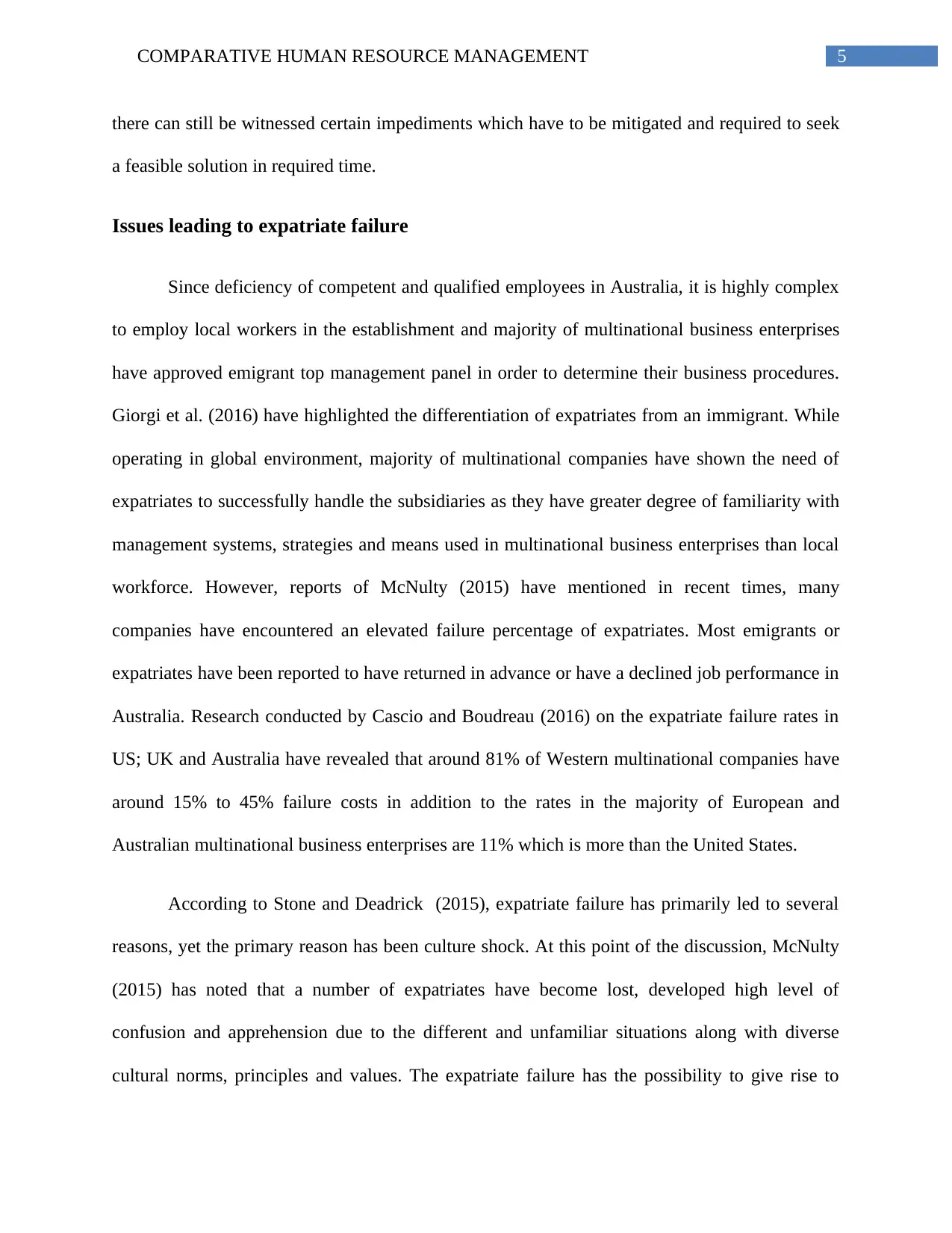
5COMPARATIVE HUMAN RESOURCE MANAGEMENT
there can still be witnessed certain impediments which have to be mitigated and required to seek
a feasible solution in required time.
Issues leading to expatriate failure
Since deficiency of competent and qualified employees in Australia, it is highly complex
to employ local workers in the establishment and majority of multinational business enterprises
have approved emigrant top management panel in order to determine their business procedures.
Giorgi et al. (2016) have highlighted the differentiation of expatriates from an immigrant. While
operating in global environment, majority of multinational companies have shown the need of
expatriates to successfully handle the subsidiaries as they have greater degree of familiarity with
management systems, strategies and means used in multinational business enterprises than local
workforce. However, reports of McNulty (2015) have mentioned in recent times, many
companies have encountered an elevated failure percentage of expatriates. Most emigrants or
expatriates have been reported to have returned in advance or have a declined job performance in
Australia. Research conducted by Cascio and Boudreau (2016) on the expatriate failure rates in
US; UK and Australia have revealed that around 81% of Western multinational companies have
around 15% to 45% failure costs in addition to the rates in the majority of European and
Australian multinational business enterprises are 11% which is more than the United States.
According to Stone and Deadrick (2015), expatriate failure has primarily led to several
reasons, yet the primary reason has been culture shock. At this point of the discussion, McNulty
(2015) has noted that a number of expatriates have become lost, developed high level of
confusion and apprehension due to the different and unfamiliar situations along with diverse
cultural norms, principles and values. The expatriate failure has the possibility to give rise to
there can still be witnessed certain impediments which have to be mitigated and required to seek
a feasible solution in required time.
Issues leading to expatriate failure
Since deficiency of competent and qualified employees in Australia, it is highly complex
to employ local workers in the establishment and majority of multinational business enterprises
have approved emigrant top management panel in order to determine their business procedures.
Giorgi et al. (2016) have highlighted the differentiation of expatriates from an immigrant. While
operating in global environment, majority of multinational companies have shown the need of
expatriates to successfully handle the subsidiaries as they have greater degree of familiarity with
management systems, strategies and means used in multinational business enterprises than local
workforce. However, reports of McNulty (2015) have mentioned in recent times, many
companies have encountered an elevated failure percentage of expatriates. Most emigrants or
expatriates have been reported to have returned in advance or have a declined job performance in
Australia. Research conducted by Cascio and Boudreau (2016) on the expatriate failure rates in
US; UK and Australia have revealed that around 81% of Western multinational companies have
around 15% to 45% failure costs in addition to the rates in the majority of European and
Australian multinational business enterprises are 11% which is more than the United States.
According to Stone and Deadrick (2015), expatriate failure has primarily led to several
reasons, yet the primary reason has been culture shock. At this point of the discussion, McNulty
(2015) has noted that a number of expatriates have become lost, developed high level of
confusion and apprehension due to the different and unfamiliar situations along with diverse
cultural norms, principles and values. The expatriate failure has the possibility to give rise to
⊘ This is a preview!⊘
Do you want full access?
Subscribe today to unlock all pages.

Trusted by 1+ million students worldwide
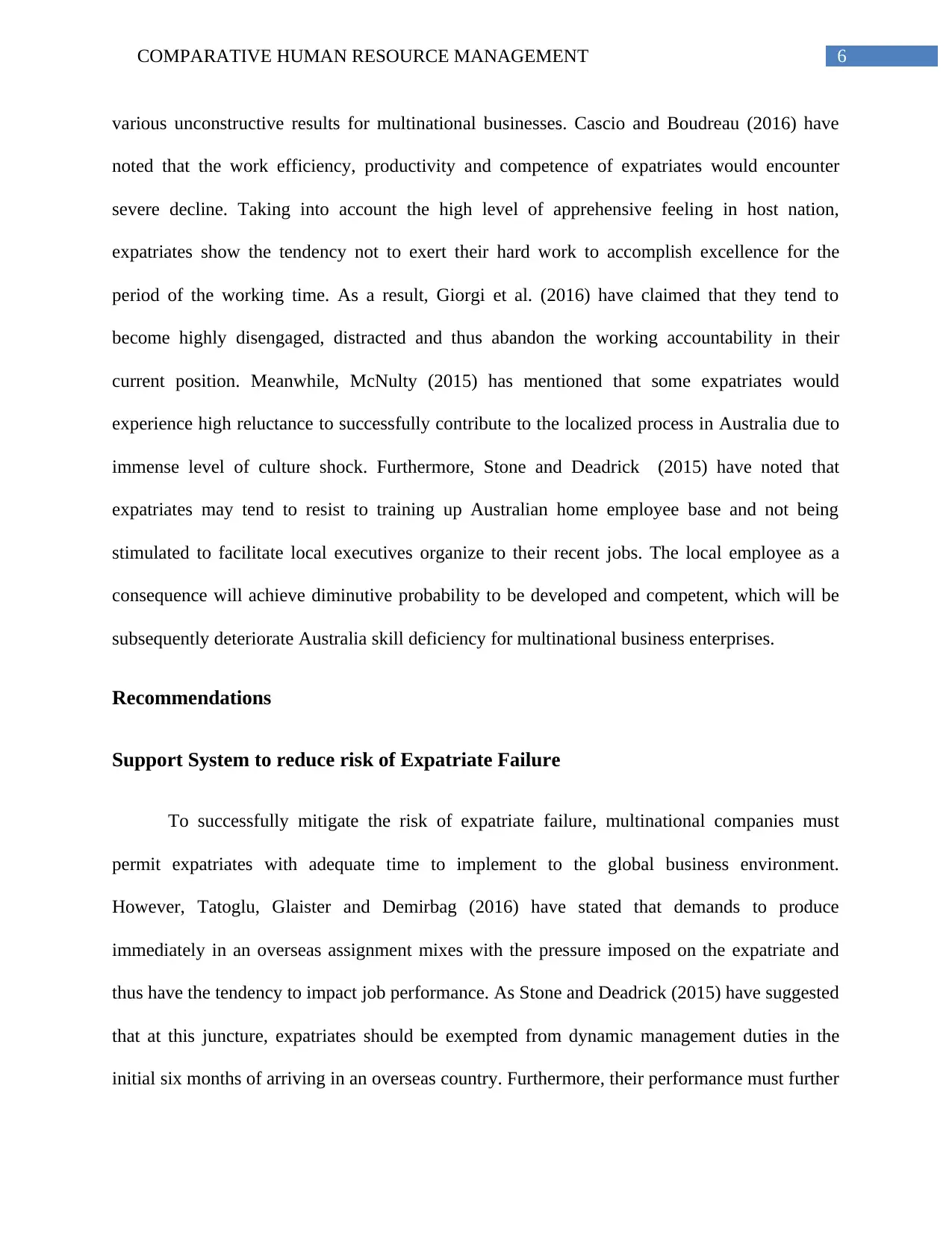
6COMPARATIVE HUMAN RESOURCE MANAGEMENT
various unconstructive results for multinational businesses. Cascio and Boudreau (2016) have
noted that the work efficiency, productivity and competence of expatriates would encounter
severe decline. Taking into account the high level of apprehensive feeling in host nation,
expatriates show the tendency not to exert their hard work to accomplish excellence for the
period of the working time. As a result, Giorgi et al. (2016) have claimed that they tend to
become highly disengaged, distracted and thus abandon the working accountability in their
current position. Meanwhile, McNulty (2015) has mentioned that some expatriates would
experience high reluctance to successfully contribute to the localized process in Australia due to
immense level of culture shock. Furthermore, Stone and Deadrick (2015) have noted that
expatriates may tend to resist to training up Australian home employee base and not being
stimulated to facilitate local executives organize to their recent jobs. The local employee as a
consequence will achieve diminutive probability to be developed and competent, which will be
subsequently deteriorate Australia skill deficiency for multinational business enterprises.
Recommendations
Support System to reduce risk of Expatriate Failure
To successfully mitigate the risk of expatriate failure, multinational companies must
permit expatriates with adequate time to implement to the global business environment.
However, Tatoglu, Glaister and Demirbag (2016) have stated that demands to produce
immediately in an overseas assignment mixes with the pressure imposed on the expatriate and
thus have the tendency to impact job performance. As Stone and Deadrick (2015) have suggested
that at this juncture, expatriates should be exempted from dynamic management duties in the
initial six months of arriving in an overseas country. Furthermore, their performance must further
various unconstructive results for multinational businesses. Cascio and Boudreau (2016) have
noted that the work efficiency, productivity and competence of expatriates would encounter
severe decline. Taking into account the high level of apprehensive feeling in host nation,
expatriates show the tendency not to exert their hard work to accomplish excellence for the
period of the working time. As a result, Giorgi et al. (2016) have claimed that they tend to
become highly disengaged, distracted and thus abandon the working accountability in their
current position. Meanwhile, McNulty (2015) has mentioned that some expatriates would
experience high reluctance to successfully contribute to the localized process in Australia due to
immense level of culture shock. Furthermore, Stone and Deadrick (2015) have noted that
expatriates may tend to resist to training up Australian home employee base and not being
stimulated to facilitate local executives organize to their recent jobs. The local employee as a
consequence will achieve diminutive probability to be developed and competent, which will be
subsequently deteriorate Australia skill deficiency for multinational business enterprises.
Recommendations
Support System to reduce risk of Expatriate Failure
To successfully mitigate the risk of expatriate failure, multinational companies must
permit expatriates with adequate time to implement to the global business environment.
However, Tatoglu, Glaister and Demirbag (2016) have stated that demands to produce
immediately in an overseas assignment mixes with the pressure imposed on the expatriate and
thus have the tendency to impact job performance. As Stone and Deadrick (2015) have suggested
that at this juncture, expatriates should be exempted from dynamic management duties in the
initial six months of arriving in an overseas country. Furthermore, their performance must further
Paraphrase This Document
Need a fresh take? Get an instant paraphrase of this document with our AI Paraphraser
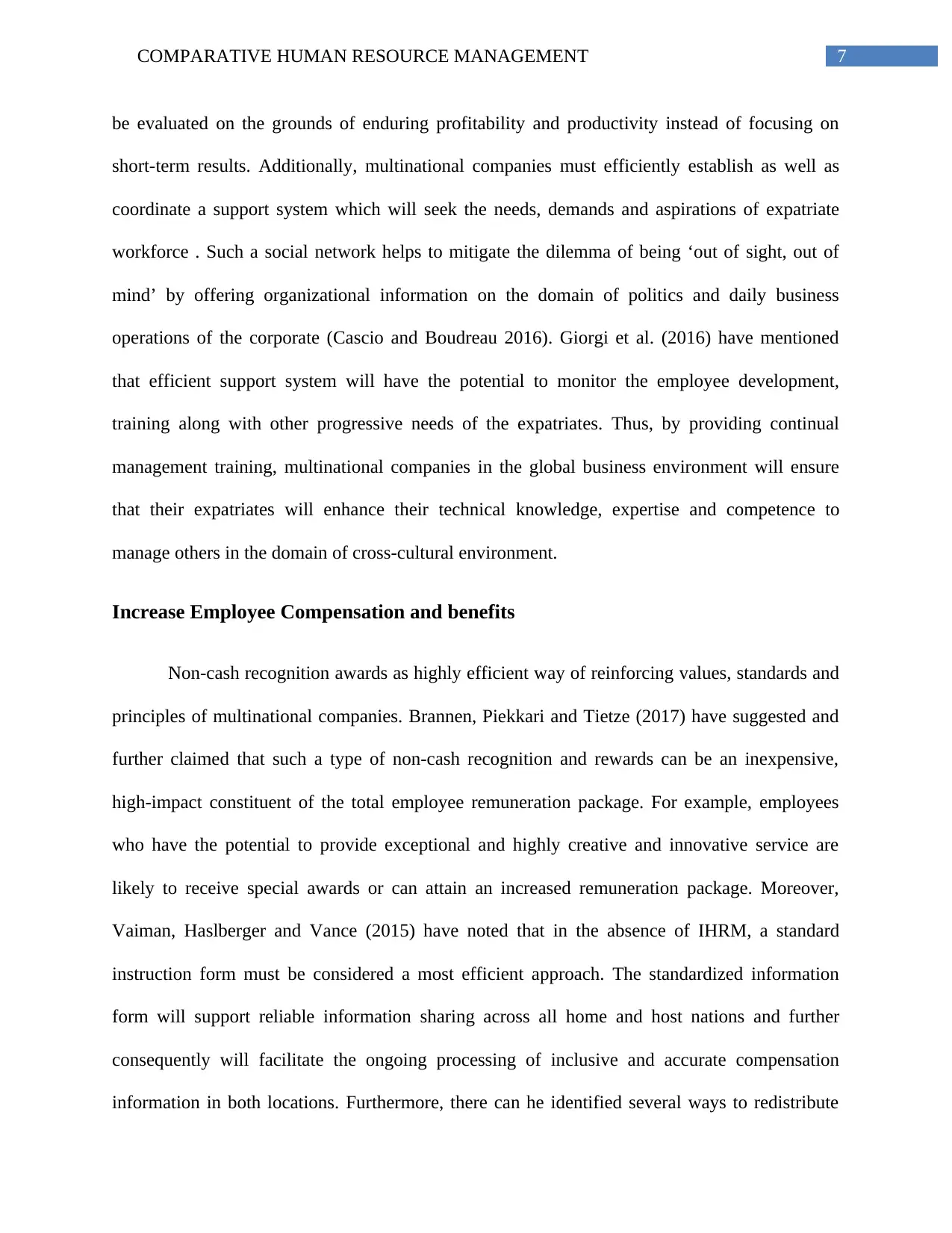
7COMPARATIVE HUMAN RESOURCE MANAGEMENT
be evaluated on the grounds of enduring profitability and productivity instead of focusing on
short-term results. Additionally, multinational companies must efficiently establish as well as
coordinate a support system which will seek the needs, demands and aspirations of expatriate
workforce . Such a social network helps to mitigate the dilemma of being ‘out of sight, out of
mind’ by offering organizational information on the domain of politics and daily business
operations of the corporate (Cascio and Boudreau 2016). Giorgi et al. (2016) have mentioned
that efficient support system will have the potential to monitor the employee development,
training along with other progressive needs of the expatriates. Thus, by providing continual
management training, multinational companies in the global business environment will ensure
that their expatriates will enhance their technical knowledge, expertise and competence to
manage others in the domain of cross-cultural environment.
Increase Employee Compensation and benefits
Non-cash recognition awards as highly efficient way of reinforcing values, standards and
principles of multinational companies. Brannen, Piekkari and Tietze (2017) have suggested and
further claimed that such a type of non-cash recognition and rewards can be an inexpensive,
high-impact constituent of the total employee remuneration package. For example, employees
who have the potential to provide exceptional and highly creative and innovative service are
likely to receive special awards or can attain an increased remuneration package. Moreover,
Vaiman, Haslberger and Vance (2015) have noted that in the absence of IHRM, a standard
instruction form must be considered a most efficient approach. The standardized information
form will support reliable information sharing across all home and host nations and further
consequently will facilitate the ongoing processing of inclusive and accurate compensation
information in both locations. Furthermore, there can he identified several ways to redistribute
be evaluated on the grounds of enduring profitability and productivity instead of focusing on
short-term results. Additionally, multinational companies must efficiently establish as well as
coordinate a support system which will seek the needs, demands and aspirations of expatriate
workforce . Such a social network helps to mitigate the dilemma of being ‘out of sight, out of
mind’ by offering organizational information on the domain of politics and daily business
operations of the corporate (Cascio and Boudreau 2016). Giorgi et al. (2016) have mentioned
that efficient support system will have the potential to monitor the employee development,
training along with other progressive needs of the expatriates. Thus, by providing continual
management training, multinational companies in the global business environment will ensure
that their expatriates will enhance their technical knowledge, expertise and competence to
manage others in the domain of cross-cultural environment.
Increase Employee Compensation and benefits
Non-cash recognition awards as highly efficient way of reinforcing values, standards and
principles of multinational companies. Brannen, Piekkari and Tietze (2017) have suggested and
further claimed that such a type of non-cash recognition and rewards can be an inexpensive,
high-impact constituent of the total employee remuneration package. For example, employees
who have the potential to provide exceptional and highly creative and innovative service are
likely to receive special awards or can attain an increased remuneration package. Moreover,
Vaiman, Haslberger and Vance (2015) have noted that in the absence of IHRM, a standard
instruction form must be considered a most efficient approach. The standardized information
form will support reliable information sharing across all home and host nations and further
consequently will facilitate the ongoing processing of inclusive and accurate compensation
information in both locations. Furthermore, there can he identified several ways to redistribute
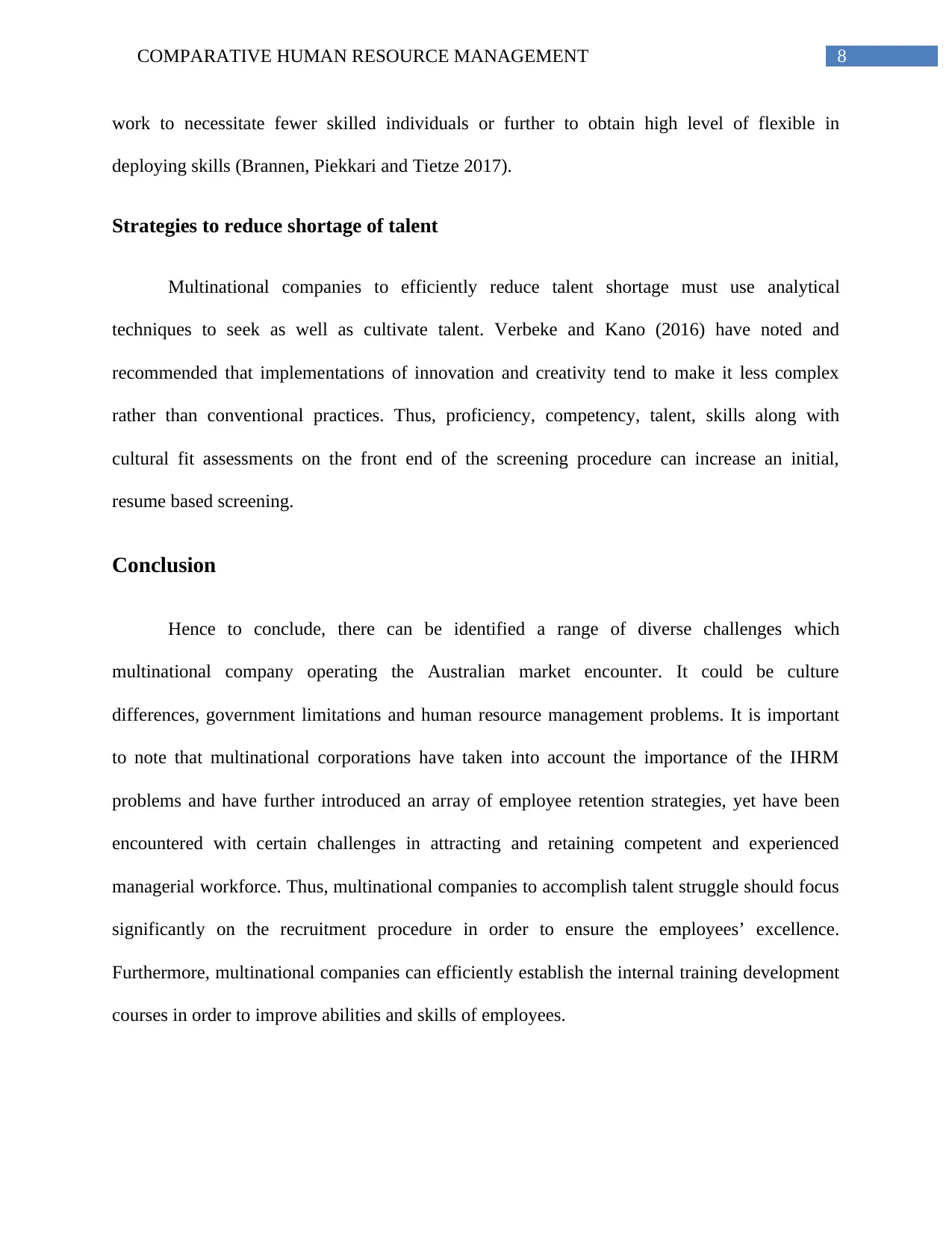
8COMPARATIVE HUMAN RESOURCE MANAGEMENT
work to necessitate fewer skilled individuals or further to obtain high level of flexible in
deploying skills (Brannen, Piekkari and Tietze 2017).
Strategies to reduce shortage of talent
Multinational companies to efficiently reduce talent shortage must use analytical
techniques to seek as well as cultivate talent. Verbeke and Kano (2016) have noted and
recommended that implementations of innovation and creativity tend to make it less complex
rather than conventional practices. Thus, proficiency, competency, talent, skills along with
cultural fit assessments on the front end of the screening procedure can increase an initial,
resume based screening.
Conclusion
Hence to conclude, there can be identified a range of diverse challenges which
multinational company operating the Australian market encounter. It could be culture
differences, government limitations and human resource management problems. It is important
to note that multinational corporations have taken into account the importance of the IHRM
problems and have further introduced an array of employee retention strategies, yet have been
encountered with certain challenges in attracting and retaining competent and experienced
managerial workforce. Thus, multinational companies to accomplish talent struggle should focus
significantly on the recruitment procedure in order to ensure the employees’ excellence.
Furthermore, multinational companies can efficiently establish the internal training development
courses in order to improve abilities and skills of employees.
work to necessitate fewer skilled individuals or further to obtain high level of flexible in
deploying skills (Brannen, Piekkari and Tietze 2017).
Strategies to reduce shortage of talent
Multinational companies to efficiently reduce talent shortage must use analytical
techniques to seek as well as cultivate talent. Verbeke and Kano (2016) have noted and
recommended that implementations of innovation and creativity tend to make it less complex
rather than conventional practices. Thus, proficiency, competency, talent, skills along with
cultural fit assessments on the front end of the screening procedure can increase an initial,
resume based screening.
Conclusion
Hence to conclude, there can be identified a range of diverse challenges which
multinational company operating the Australian market encounter. It could be culture
differences, government limitations and human resource management problems. It is important
to note that multinational corporations have taken into account the importance of the IHRM
problems and have further introduced an array of employee retention strategies, yet have been
encountered with certain challenges in attracting and retaining competent and experienced
managerial workforce. Thus, multinational companies to accomplish talent struggle should focus
significantly on the recruitment procedure in order to ensure the employees’ excellence.
Furthermore, multinational companies can efficiently establish the internal training development
courses in order to improve abilities and skills of employees.
⊘ This is a preview!⊘
Do you want full access?
Subscribe today to unlock all pages.

Trusted by 1+ million students worldwide

9COMPARATIVE HUMAN RESOURCE MANAGEMENT
Paraphrase This Document
Need a fresh take? Get an instant paraphrase of this document with our AI Paraphraser
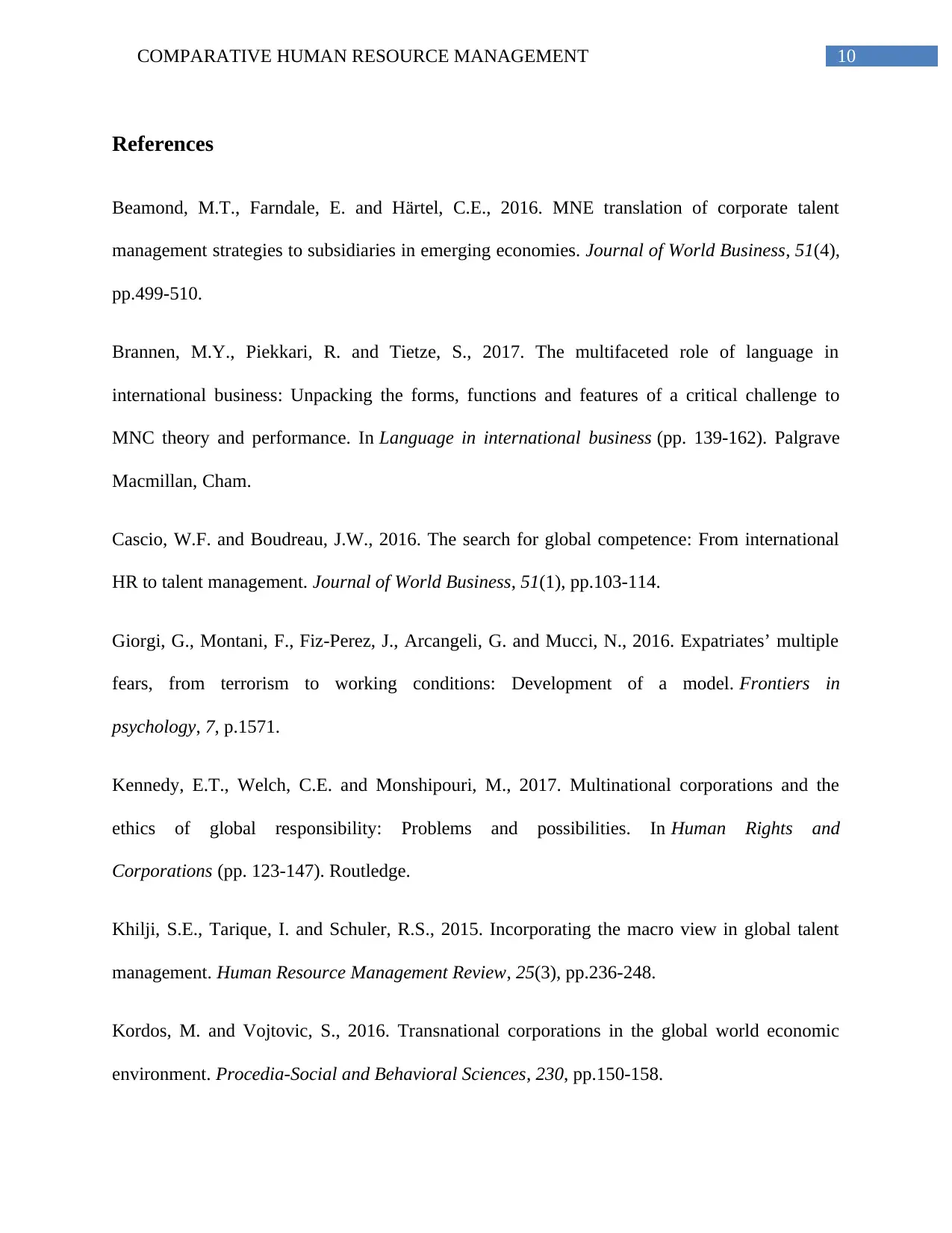
10COMPARATIVE HUMAN RESOURCE MANAGEMENT
References
Beamond, M.T., Farndale, E. and Härtel, C.E., 2016. MNE translation of corporate talent
management strategies to subsidiaries in emerging economies. Journal of World Business, 51(4),
pp.499-510.
Brannen, M.Y., Piekkari, R. and Tietze, S., 2017. The multifaceted role of language in
international business: Unpacking the forms, functions and features of a critical challenge to
MNC theory and performance. In Language in international business (pp. 139-162). Palgrave
Macmillan, Cham.
Cascio, W.F. and Boudreau, J.W., 2016. The search for global competence: From international
HR to talent management. Journal of World Business, 51(1), pp.103-114.
Giorgi, G., Montani, F., Fiz-Perez, J., Arcangeli, G. and Mucci, N., 2016. Expatriates’ multiple
fears, from terrorism to working conditions: Development of a model. Frontiers in
psychology, 7, p.1571.
Kennedy, E.T., Welch, C.E. and Monshipouri, M., 2017. Multinational corporations and the
ethics of global responsibility: Problems and possibilities. In Human Rights and
Corporations (pp. 123-147). Routledge.
Khilji, S.E., Tarique, I. and Schuler, R.S., 2015. Incorporating the macro view in global talent
management. Human Resource Management Review, 25(3), pp.236-248.
Kordos, M. and Vojtovic, S., 2016. Transnational corporations in the global world economic
environment. Procedia-Social and Behavioral Sciences, 230, pp.150-158.
References
Beamond, M.T., Farndale, E. and Härtel, C.E., 2016. MNE translation of corporate talent
management strategies to subsidiaries in emerging economies. Journal of World Business, 51(4),
pp.499-510.
Brannen, M.Y., Piekkari, R. and Tietze, S., 2017. The multifaceted role of language in
international business: Unpacking the forms, functions and features of a critical challenge to
MNC theory and performance. In Language in international business (pp. 139-162). Palgrave
Macmillan, Cham.
Cascio, W.F. and Boudreau, J.W., 2016. The search for global competence: From international
HR to talent management. Journal of World Business, 51(1), pp.103-114.
Giorgi, G., Montani, F., Fiz-Perez, J., Arcangeli, G. and Mucci, N., 2016. Expatriates’ multiple
fears, from terrorism to working conditions: Development of a model. Frontiers in
psychology, 7, p.1571.
Kennedy, E.T., Welch, C.E. and Monshipouri, M., 2017. Multinational corporations and the
ethics of global responsibility: Problems and possibilities. In Human Rights and
Corporations (pp. 123-147). Routledge.
Khilji, S.E., Tarique, I. and Schuler, R.S., 2015. Incorporating the macro view in global talent
management. Human Resource Management Review, 25(3), pp.236-248.
Kordos, M. and Vojtovic, S., 2016. Transnational corporations in the global world economic
environment. Procedia-Social and Behavioral Sciences, 230, pp.150-158.
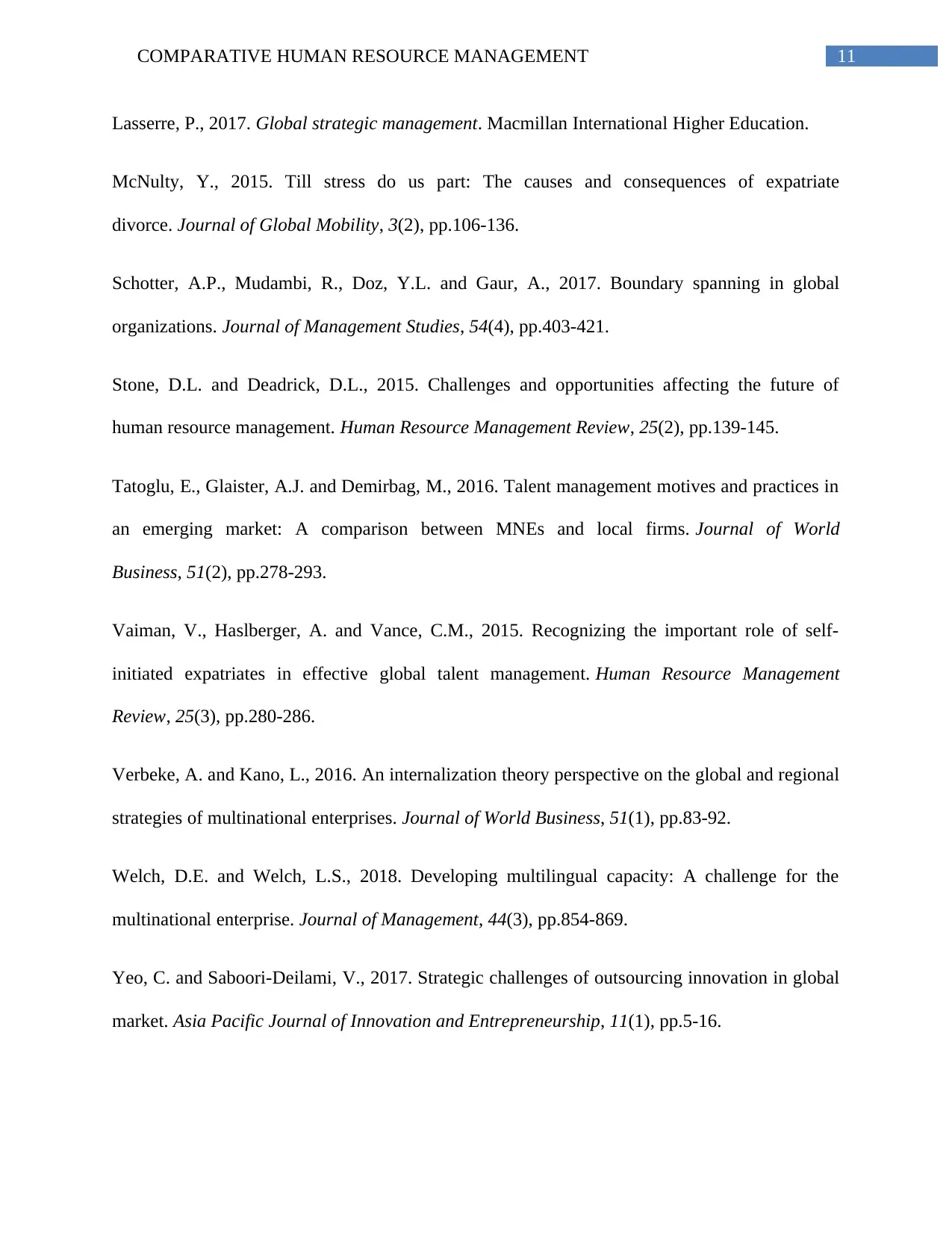
11COMPARATIVE HUMAN RESOURCE MANAGEMENT
Lasserre, P., 2017. Global strategic management. Macmillan International Higher Education.
McNulty, Y., 2015. Till stress do us part: The causes and consequences of expatriate
divorce. Journal of Global Mobility, 3(2), pp.106-136.
Schotter, A.P., Mudambi, R., Doz, Y.L. and Gaur, A., 2017. Boundary spanning in global
organizations. Journal of Management Studies, 54(4), pp.403-421.
Stone, D.L. and Deadrick, D.L., 2015. Challenges and opportunities affecting the future of
human resource management. Human Resource Management Review, 25(2), pp.139-145.
Tatoglu, E., Glaister, A.J. and Demirbag, M., 2016. Talent management motives and practices in
an emerging market: A comparison between MNEs and local firms. Journal of World
Business, 51(2), pp.278-293.
Vaiman, V., Haslberger, A. and Vance, C.M., 2015. Recognizing the important role of self-
initiated expatriates in effective global talent management. Human Resource Management
Review, 25(3), pp.280-286.
Verbeke, A. and Kano, L., 2016. An internalization theory perspective on the global and regional
strategies of multinational enterprises. Journal of World Business, 51(1), pp.83-92.
Welch, D.E. and Welch, L.S., 2018. Developing multilingual capacity: A challenge for the
multinational enterprise. Journal of Management, 44(3), pp.854-869.
Yeo, C. and Saboori-Deilami, V., 2017. Strategic challenges of outsourcing innovation in global
market. Asia Pacific Journal of Innovation and Entrepreneurship, 11(1), pp.5-16.
Lasserre, P., 2017. Global strategic management. Macmillan International Higher Education.
McNulty, Y., 2015. Till stress do us part: The causes and consequences of expatriate
divorce. Journal of Global Mobility, 3(2), pp.106-136.
Schotter, A.P., Mudambi, R., Doz, Y.L. and Gaur, A., 2017. Boundary spanning in global
organizations. Journal of Management Studies, 54(4), pp.403-421.
Stone, D.L. and Deadrick, D.L., 2015. Challenges and opportunities affecting the future of
human resource management. Human Resource Management Review, 25(2), pp.139-145.
Tatoglu, E., Glaister, A.J. and Demirbag, M., 2016. Talent management motives and practices in
an emerging market: A comparison between MNEs and local firms. Journal of World
Business, 51(2), pp.278-293.
Vaiman, V., Haslberger, A. and Vance, C.M., 2015. Recognizing the important role of self-
initiated expatriates in effective global talent management. Human Resource Management
Review, 25(3), pp.280-286.
Verbeke, A. and Kano, L., 2016. An internalization theory perspective on the global and regional
strategies of multinational enterprises. Journal of World Business, 51(1), pp.83-92.
Welch, D.E. and Welch, L.S., 2018. Developing multilingual capacity: A challenge for the
multinational enterprise. Journal of Management, 44(3), pp.854-869.
Yeo, C. and Saboori-Deilami, V., 2017. Strategic challenges of outsourcing innovation in global
market. Asia Pacific Journal of Innovation and Entrepreneurship, 11(1), pp.5-16.
⊘ This is a preview!⊘
Do you want full access?
Subscribe today to unlock all pages.

Trusted by 1+ million students worldwide
1 out of 12
Related Documents
Your All-in-One AI-Powered Toolkit for Academic Success.
+13062052269
info@desklib.com
Available 24*7 on WhatsApp / Email
![[object Object]](/_next/static/media/star-bottom.7253800d.svg)
Unlock your academic potential
Copyright © 2020–2025 A2Z Services. All Rights Reserved. Developed and managed by ZUCOL.





